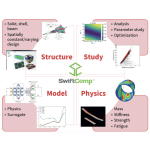Applications
AnalySwift products for efficient high-fidelity modeling of composites and other advanced materials have multiple applications. VABS enables rigorous simulation of composite slender structures, commonly called beams, based on decades of research support from the US Army for solving the helicopter rotor blade modeling problem. It is primarily used for rotorcraft blades (helicopter, air mobility, eVTOL), wind turbine rotors, propellers, landing gear, and other slender composite structures. SwiftComp extends the many advantages of VABS to the modeling of composite plates, shells, and 3D solid structures. While SwiftComp can also model composite beams, it does so somewhat differently than VABS (see below). SwiftComp is very versatile and has applications ranging from modeling composite deployable space structures (booms, etc.), pressure vessels, printed circuit boards, performance fishing rods, and a wide range of materials, including advanced composites, metamaterials, thin-ply composites, concrete, coatings, bio-composites. and many more.
SwiftComp
SwiftComp is a general-purpose multiscale modeling code that enables users to perform efficient and accurate modeling of composites. It can be used either independently as a tool for virtual testing of composites or as a plugin to power conventional FEA codes with high-fidelity multiscale modeling for composites. SwiftComp provides unified modeling for various types of structures including 1D (beams), 2D (plates/shells), woven, and 3D structures. It saves hours in computing time and resources with accuracy comparable to modeling all the microstructural details using 3D FEA. SwiftComp quickly calculates the complete set of effective properties needed for use in macroscopic structural analysis. It can also predict accurate local stresses and strains in the microstructure for the purpose of predicting strengths, as well as thermal expansion of composites. SwiftComp also has initial failure analysis capabilities, including predicting pointwise failure strengths distributions, failure envelopes, and effective failure strength for the composite. In addition to composites, SwiftComp provides novel simulation capabilities for metamaterials, architected materials, porous materials, tailorable composites etc. It interfaces with ANSYS, ABAQUS, NASTRAN, and TexGen. The program is licensed by AnalySwift from Purdue Research Foundation. The latest version, SwiftComp 2.1, adds many new capabilities, including the prediction of viscoelastic properties, thermoviscoelastic properties and composites failure, as well as AI-assisted composites simulation.
VABS
VABS is a general-purpose cross-sectional analysis tool for computing beam properties and recovering 3D stresses/strains of slender composite structures. It is a powerful tool for modeling composite helicopter and wind turbine rotor blades, as well as other slender composite structures, such as propellers, landing gear, and high-aspect ratio wings. VABS can calculate ply-level details with the accuracy of 3D FEA in seconds on a typical laptop computer. VABS is capable of rigorously reducing an original 3D slender solid with complex cross-sections into a simple engineering beam model. With continuous development funded by the US Army spanning over 30 years for performance and robustness, VABS’ accuracy has been extensively verified by its developers and users. With its new, open source preprocessing tool, PreVABS, VABS is easier to use than ever. It also interfaces with ANSYS and ABAQUS and to a more limited degree, CATIA. The program is licensed by AnalySwift from Utah State University,Georgia Institute of Technology, and Purdue University.
Please contact us today for a free trial version of any of our modeling tools.
Should I use SwiftComp or VABS? Depends what you are modeling…
| SwiftComp | VABS |
|---|---|
| Beams* | Beams* |
| Plates & Shells | |
| 3D Solid Structures |
*Which should I use for composite beams?
Your composite beam modeling needs depend on whether you have composite beams with well defined cross-sections or more general types of composite structures. SwiftComp can handle general types of composite structures, but the major differences are two-fold:
- For beams with more constant cross sections, VABS has more capabilities than SwiftComp such as Vlasov model, mass properties, etc. VABS is more often used for composite blades.
- SwiftComp can deal with heterogeneity along the beam axis while VABS cannot. If there is no heterogeneity along the length direction, you can use either. Otherwise, one should use SwiftComp.

MULTISCALE MODELING OF COMPOSITES
3D composite structures
- Binary composites
- Fiber reinforced composites
- Particle reinforced composites
- Textile composites
- Short fiber composites
- Porous materials
- Foams
- Other heterogeneous materials
2D Composite plates/shells
- Laminates
- Stiffened panels
- Corrugated structures
- Perforated structures
- Sandwich structures
- Unitized structures
- And more
1D Composite beams
- Helicopter rotor blades
- Wind turbine blades
- Propellers
- High-aspect wings
- Golf clubs
- Fishing rod
- And other slender composites structures
VIRTUAL TESTING OF COMPOSITES
Mechanical properties
- Elastic constants
- Static strength
Multiphysical properties
- Conductivities
- Dielectric
- Magnetic
- Diffusive properties
- Coefficients of thermal expansion
- Specific heat
- Electromagnetic properties

MULTISCALE MODELING OF COMPOSITES
- Helicopter rotor blades
- Air mobility blades (AAM/UAM/eVTOL/UAV)
- Wind turbine blades
- Propellers
- Landing gear
- High-aspect ratio wings
- Golf clubs
- Fishing rods
- Tubes, rods, shafts, columns
- Other slender composite structures
VIRTUAL TESTING OF COMPOSITES BEAMS
- Complete set of best multiphysical properties: needed for static/dynamic analysis using beam elements.
- Complete set of accurate multiphysical 3D fields: analyze under coupled effects of thermal, mechanical, and electromagnetic fields.
- Material properties: no restrictions on material properties and can handle any material, including isotropic, orthotropic, and anisotropic materials.
- Highly optimized for efficiency: ply-level details of real blades can be modeled in seconds.
- Directly integrated into other design environments, including ANSYS, ABAQUS, and HyperMesh/OptiStruct.
- Reap the full benefits of VABS using free companion code GEBT (1D beam analysis), which accepts the full stiffness matrix.
- Compute pointwise distributions of failure indexes and strength ratios over the cross section under given load.
- Compute the safety margin of the cross section under a given load.
- Output the nodal stress/strain values according to the original numbering of the finite element nodes.
- Output the complete set of engineering properties commonly used in conventional beam analysis including extension stiffness (EA), torsional stiffness (GJ), principal bending stiffnesses (EI22, EI33), principal shear stiffnesses (GA22, GA33), tension center, shear center, principal inertia axis, principal bending axis, and principal shear axis.







